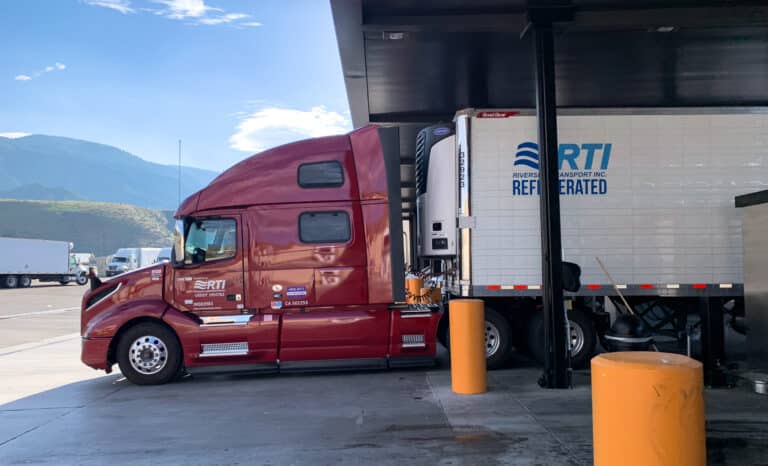The introduction of the electronic logging device (ELD) mandate has reshaped the transportation industry, ushering in a new era of digital record-keeping. While the mandate has been widely discussed in the context of interprovincial commercial motor vehicle (CMV) operations, its implications for intraprovincial drivers are equally significant. Intraprovincial truckers, who operate within the boundaries of a single province, must also navigate the complexities of ELD requirements to ensure compliance and maintain efficient operations.
According to Transport Canada, the ELD mandate applies to most CMV drivers, including those operating in intraprovincial commerce. The aim of this article is to explore the ELD requirements specifically for intraprovincial CMV drivers, shedding light on the compliance obligations and exploring how to harness ELDs for enhanced productivity, safety, and overall operational efficiency. By gaining a deeper understanding of the intraprovincial ELD mandate and its implications, truckers can ensure compliance while unlocking the potential benefits of digital logging technology.
Understanding the Intraprovincial ELD Mandates
To grasp the significance of intraprovincial ELD requirements, it is crucial to understand the distinction between intraprovincial and interprovincial operations. Intraprovincial commerce refers to the transportation of goods or passengers within the boundaries of a single province, without crossing provincial borders. In contrast, interprovincial commerce involves the movement of goods or passengers across provincial boundaries.
The electronic logging device mandate, which took full effect in January 2023, requires most CMV drivers to use electronic logging devices to record their hours of service (HOS) data. Is ELD required for intraprovincial operations, then? This mandate applies to both interprovincial and intraprovincial drivers, with some exceptions based on specific operating characteristics—which will be discussed later on. The basic premise of the mandate is to ensure accurate and tamper-proof recording of driver HOS, promoting compliance with regulations and enhancing road safety. While most provinces have adopted the federal ELD regulations for intraprovincial operations, some provinces may have additional or modified requirements. Let’s take a closer look at some examples:
Ontario
Ontario has adopted the federal ELD regulations for intraprovincial operations, with a few additional requirements. Intraprovincial drivers in Ontario must use electronic logbooks unless they qualify for one of the province’s exemptions, such as the 160-kilometer radius exemption or the exemption for commercial motor vehicles manufactured before the year 2000. Ontario also requires motor carriers to retain ELD records for a minimum of six months and to make them available for inspection upon request. The Ontario Ministry of Transportation enforces Ontario’s intraprovincial ELD mandate and other province-specific transportation rules.

Quebec
Quebec has adopted the federal ELD regulations for intraprovincial operations without any significant modifications. Intraprovincial drivers in Quebec must comply with the mandate unless they qualify for one of the federal exemptions, such as the 160-kilometer radius exemption or the exemption for commercial motor vehicles manufactured before the year 2000. The Société de l’assurance automobile du Québec (SAAQ) is responsible for enforcing Quebec’s intraprovincial ELD mandate and other province-specific regulations.
Alberta
Alberta has adopted the federal ELD regulations for intraprovincial operations, with some additional provisions. Intraprovincial drivers in Alberta must use electronic logbooks unless they qualify for one of the province’s exemptions, such as the 160-kilometer radius exemption or the farm vehicle exemption. Alberta also requires motor carriers to retain ELD records for a minimum of six months and to make them available for inspection upon request. Alberta Transportation enforces Alberta’s intraprovincial ELD mandate and other province-specific transportation regulations.
British Columbia
British Columbia has adopted the federal ELD regulations for intraprovincial operations without any significant modifications. Intraprovincial drivers in British Columbia must comply with the mandate unless they qualify for one of the federal exemptions, such as the 160-kilometer radius exemption or the exemption for commercial motor vehicles manufactured before the year 2000. The British Columbia Ministry of Transportation and Infrastructure is responsible for enforcing British Columbia’s intraprovincial ELD mandate and other province-specific regulations.
Manitoba
Manitoba has adopted the federal ELD regulations for intraprovincial operations, with some additional requirements. Intraprovincial drivers in Manitoba must use electronic logbooks unless they qualify for one of the province’s exemptions, such as the 160-kilometer radius exemption or the agricultural operations exemption. Manitoba also requires motor carriers to retain ELD records for a minimum of six months and to make them available for inspection upon request. Manitoba Infrastructure enforces Manitoba’s intraprovincial ELD mandate and other province-specific rules.
It’s important to note that provincial regulations can change over time, and it’s always best to consult with their province’s transportation department or Transport Canada for the most up-to-date information on ELD requirements for intraprovincial CMV drivers. Additionally, drivers operating in multiple provinces should ensure compliance with each province’s specific regulations to avoid potential violations and penalties.

Intraprovincial Driver Hours of Service
Intraprovincial CMV drivers are subject to HOS regulations that govern the amount of time they can spend driving and working. While intraprovincial HOS rules are generally similar to interprovincial regulations, there may be some variations depending on the province.
The most common intraprovincial HOS regulations include:
- 13-hour driving limit. Intraprovincial drivers are allowed to drive a maximum of 13 hours after 8 consecutive hours off duty.
- 14-hour duty limit. Intraprovincial drivers cannot drive beyond the 14th hour after coming on duty, following 8 consecutive hours off duty.
- 70-hour duty limit. Intraprovincial drivers cannot drive after 70 hours on duty in 7 consecutive days. A driver may restart a 7-consecutive day period after taking 36 or more consecutive hours off duty.
- Rest breaks. Intraprovincial drivers must take a 30-minute break when they have driven for a period of 8 cumulative hours without at least a 30-minute interruption.
It is essential for operators to understand and comply with their province’s specific HOS regulations. While many provinces have adopted the federal hours of service regulations for intraprovincial commerce, some provinces have implemented their own specific intraprovincial HOS rules. Here are a few examples:
Ontario
- Property-carrying drivers. 13 hours of driving time within a 16-hour window after 8 consecutive hours off duty.
- Passenger-carrying drivers. 13 hours of driving time within a 15-hour window after 8 consecutive hours off duty.
- Drivers are required to take a 30-minute rest break after driving for 8 hours.
Quebec
- Property-carrying drivers. 13 hours of driving time within a 16-hour window after 8 consecutive hours off duty.
- Passenger-carrying drivers. 13 hours of driving time within a 16-hour window after 8 consecutive hours off duty.
- Drivers are required to take a 30-minute rest break after driving for 8 hours.
Alberta
- Property-carrying drivers. 13 hours of driving time within a 15-hour window after 8 consecutive hours off duty.
- Passenger-carrying drivers. 13 hours of driving time within a 15-hour window after 8 consecutive hours off duty.
- Drivers are required to take a 30-minute rest break after driving for 8 hours.
British Columbia
- Property-carrying drivers. 13 hours of driving time within a 16-hour window after 8 consecutive hours off duty.
- Passenger-carrying drivers. 13 hours of driving time within a 16-hour window after 8 consecutive hours off duty.
Manitoba
- Property-carrying drivers. 13 hours of driving time within a 16-hour window after 8 consecutive hours off duty.
Failure to adhere to these rules can result in violations, fines, and potential impacts on a driver’s safety record. According to data from Transport Canada, HOS violations are among the most common violations found during roadside inspections, emphasizing the importance of intraprovincial drivers familiarizing themselves with HOS regulations and using ELDs to ensure compliance and avoid violations.
When Do Intraprovincial Drivers Need ELDs?
One of the most common questions among intraprovincial CMV drivers is whether they are required to use electronic logging devices to record their hours of service. As previously discussed, many intraprovincial drivers are required to use ELDs, just like their interprovincial counterparts. Transport Canada’s ELD mandate applies to commercial buses and trucks engaged in interprovincial commerce. However, many provinces have adopted the federal ELD regulations for intraprovincial operations as well.
There are some general exceptions, including:
- Short-haul operations. Some provinces may exempt intraprovincial drivers from ELD requirements if they operate within a certain kilometer radius of their work reporting location and meet other specific criteria, such as returning to their work reporting location daily and not exceeding a certain number of hours on duty.
- Older vehicles. Some provinces may exempt intraprovincial drivers operating vehicles manufactured before the year 2000.
- Specific cargo. Certain types of cargo, such as agricultural commodities or livestock, may have ELD exemptions in some provinces.
It is crucial for drivers to check with their province’s transportation department or Transport Canada to determine the specific ELD requirements that apply to their operations. Failing to comply with these regulations can result in fines, penalties, and other enforcement actions. By staying informed about their province’s specific regulations and using compliant electronic logging solutions, intraprovincial drivers can avoid costly violations and ensure smoother operations.
ELD Requirements for Intraprovincial CMV Drivers

When it comes to ELD requirements for intraprovincial drivers, there are several key aspects to consider, including device specifications, documentation, and record-keeping. Understanding and adhering to these requirements is essential for maintaining compliance and avoiding penalties.
Device Specifications
Intraprovincial CMV drivers required to use electronic logbooks must ensure that their devices meet the technical specifications set forth by Transport Canada. These specifications include:
- Automatic recording of engine hours, vehicle kilometers, and location information
- Tamper-resistant design to prevent data alteration
- Ability to display and transfer data to law enforcement during roadside inspections
- Compliance with Transport Canada’s self-certification process and registration
Documentation and Record-Keeping
In addition to using compliant ELD devices, intraprovincial CMV drivers must also adhere to documentation and record-keeping requirements. These include:
- Maintaining ELD records for at least six months, including backup data
- Providing ELD records to law enforcement upon request during roadside inspections
- Keeping an ELD user manual and instruction sheet in the vehicle
- Maintaining a supply of blank driver’s records of duty status (RODS) graph-grids to record HOS manually in case of device malfunctions
According to Transport Canada, during the initial implementation of the mandate, there were a significant number of ELD violations issued during roadside inspections. This highlights the importance of intraprovincial drivers ensuring their electronic logbooks meet the required specifications and that they follow proper documentation and record-keeping practices.
HOS247 ELDs for Federal and Intrastate Compliance
Choosing the right technology provider is crucial for truckers drivers to ensure compliance with both federal and provincial regulations. HOS247 offers a reliable and user-friendly ELD solution that supports both inter- and intraprovincial HOS rules. Here’s how HOS247 electronic logbooks bring substantial advantages to carriers operating within and across provincial boundaries:
1. Multilingual Customer Support
- Top-rated service. HOS247 is recognized for its exceptional customer support available every day of the week. Our team offers assistance in multiple languages including English, Spanish, Polish, and Russian, ensuring that all drivers and fleet managers receive the help they need.
- Ease of access. The support team is easily reachable, providing prompt and effective solutions to any queries or issues that may arise, ensuring that operations run smoothly without interruption.
- Call-back policy. If the call gets interrupted, we will call you back every time.
2. Flexible Subscription Plans with No Contracts
- Adaptable to business needs. HOS247 offers flexible, scalable subscription plans that cater to the specific needs of both inter- and intraprovincial operations. Fleets can add or remove features such as IFTA calculations and GPS tracking based on their changing requirements.
- No long-term commitments. The absence of binding contracts allows fleets the freedom to adjust their service plans as operational needs evolve, without the worry of incurring penalties or undergoing complex cancellation processes.
3. One-Year Hardware Warranty
- Reliability assured. All hardware provided by HOS247 comes with a one-year warranty, emphasizing our commitment to quality and durability. This warranty ensures that any hardware issues are promptly addressed, maintaining the continuity and reliability of fleet operations.
- Ease of installation. Our hardware solutions are designed to be durable and easy to install, featuring stable Bluetooth connectivity that integrates seamlessly with the ELD app. This simplicity aids in reducing setup times and potential installation errors.
4. Comprehensive Fleet Management Features
- Real-time GPS tracking. For fleets that traverse state lines or operate within specific regions, real-time GPS tracking enables precise monitoring of vehicle locations and movements, facilitating optimal route planning and quick response to unexpected conditions.
- Maintenance and diagnostics. Proactive maintenance alerts and vehicle diagnostics help prevent breakdowns and extend vehicle life, which are critical for maintaining operational efficiency in both short and long-haul operations.
5. Two-week Trial Period
- Risk-free evaluation. HOS247 offers a two-week trial period that allows fleets to thoroughly test the system and evaluate its impact on their operations. If the platform does not meet your expectations, it can be returned for a full refund, making the initial adoption virtually risk-free.
By partnering with a trusted provider like HOS247, intrastate drivers can have peace of mind knowing they are using a reliable and compliant solution that meets the required standards and supports their province’s specific HOS rules.

Making the Most Out of ELDs: Benefits Beyond Compliance
While the primary purpose of electronic logs is to ensure compliance with HOS regulations, taking a proactive approach to their usage and data analysis can enhance operational efficiency, improve safety, and boost their bottom line.
Optimizing Routes and Reducing Fuel Costs
Electronic logbooks provide valuable insights into vehicle performance and driver behavior, enabling truckers to optimize their routes and reduce fuel consumption. By analyzing ELD data, drivers can identify inefficient driving patterns, such as excessive idling or hard braking, and make necessary adjustments to improve fuel efficiency. According to a study by the North American Council for Freight Efficiency (NACFE), implementing ELDs and using the data to optimize routes and driver behavior can lead to fuel savings of up to 5% (NACFE, 2019).
Enhancing Safety and Reducing Accidents
By monitoring driver behavior and providing real-time alerts for potential violations, ELDs help prevent fatigue-related accidents and promote safer driving practices. A study by Transport Canada found that the use of electronic logging devices reduced the total crash rate for large trucks by a significant percentage. By leveraging ELD data to identify and address risky driving behaviors, intraprovincial truckers can contribute to a safer working environment for themselves and other road users.
Streamlining Maintenance and Reducing Downtime
Unplanned maintenance and breakdowns can cost trucking companies significant amounts per incident. Electronic logbooks can help intraprovincial CMV drivers streamline their vehicle maintenance processes and reduce downtime. Many ELD solutions integrate with vehicle diagnostic systems, providing real-time alerts for potential maintenance issues and helping drivers schedule preventive maintenance more effectively. By staying on top of maintenance needs and addressing issues proactively, truckers can minimize unexpected breakdowns and reduce costly downtime.
Improving Customer Service and Load Planning
ELD data can be used to improve customer service and streamline load planning. By accurately tracking HOS and predicting driver availability, truckers can provide more reliable delivery estimates to their customers and optimize their load assignments. This not only enhances customer satisfaction but also helps truckers maximize their productivity and revenue potential.
As the trucking industry continues to evolve, commercial drivers must stay informed about the latest regulations and technologies to remain competitive and compliant. By understanding intraprovincial ELD mandates and embracing the benefits of electronic logging devices, truckers can position themselves for success in an increasingly digital and data-driven industry.

As an expert in B2B and B2C sales, I’ve dedicated myself to perfecting sales processes and client retention strategies in the logistics and trucking industry. I have significantly contributed to the expansion of the ELD service, catering to retail and wholesale clients in need of HOS247 ELD solutions. My unwavering commitment to implementing state-of-the-art sales techniques and technologies ensures the continuous growth and success of businesses I work with.










User-friendly ELDs and accompanying apps are more important now than ever, as the mandate approaches and driver turnover continues to be a problem for trucking businesses. Difficult to navigate logbook apps make drivers’ jobs more complicated. That is one more

GPS fleet tracking for small businesses is one of the most cost-effective and useful tools found in the trucking sector. Smaller-scale businesses can perform very well because of their capacity for lean management. Using technology to optimize processes and effectively

What Is the Canadian ELD Mandate? The Canadian ELD mandate was announced on June 13, 2019, by the Canadian Minister of Transport Marc Garneau and went into effect on June 12, 2021. The progressive enforcement period announced by Canadian authorities